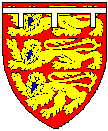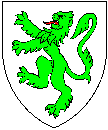

Back to the Lions and Glossary.
The terms used to describe the body positions or postures of lions are also used for other animals such as wolves and bears, and most monsters. Deer have their own terms.
The following terms are used for the body positions:
 Passant |
 Statant |
 Salient |
 Rampant Reguardant |
 Sejant Erect |
 Sejant |
 Couchant |
 Dormant |
The names are all derived from (old) French:
| Passant | Walking past, shown with one foot raised |
| Statant | Standing, with all four feet on the ground |
| Salient | Leaping or jumping, with both front paws off the ground, and both rear paws on it |
| Rampant | Rearing up, with only one (rear) paw on the ground |
| Sejant Erect | Sitting, but with the front paws raised up, similar to rampant |
| Sejant | Seated or sitting |
| Couchant | Lying down, but with the head raised; the lion is awake |
| Dormant | Lying down, asleep. The head is down with the eyes closed. Sometimes the head rests on the front paws, sometimes beside them. The tail is sometimes depicted down lying on the ground alongside the back legs |
Occasionally a lion is shown sejant affronté , i.e. sitting, and with the whole body facing directly out of the shield.
Sometimes one sees a demi-lion – the front half of a lion. Lions’ heads and faces are also common charges, other body parts such as the gambs or jambs (legs) or tails less so. Rarely one comes across a lion with his tail between his legs, in which case he is said to be cowed or coward. The tail can also be extended straight out behind, knotted or nowed, forked or fourché, or the lion may even have two tails and be double- or 2-queued.
Normally the lion’s head faces to the left (as viewed), but it can also be g(u)ardant when facing out of the shield (see Brotherton above) or reg(u)ardant when looking backwards.
Back to the Glossary Contents.
© Gill Smith 1997, 1998